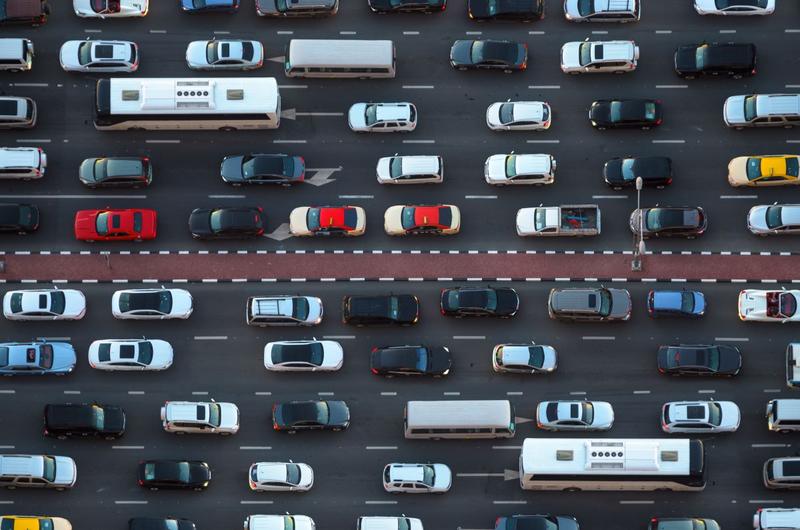Reckless Drivers Are Still on the Road

[music]
Brigid Bergin: It's The Brian Lehrer Show on WNYC. Welcome back everybody. I'm Brigid Bergin from the WNYC and Gothamist newsroom filling in for Brian today. On Saturday, a reckless driver in Brooklyn allegedly ran a red light and collided with another car. Both vehicles careened into three pedestrians; a 33-year-old woman, a 36-year-old man and a three-month-old baby being pushed in a stroller by her mom on the sidewalk who was killed.
The driver reportedly had dozens of traffic violations to his name. Street safety advocates took to city hall after the crash lining up a row of all white ghost strollers to symbolize children killed by drivers. You may have seen those white ghost bikes around the city. Advocates are blaming Mayor de Blasio for not implementing the Reckless Drivers Accountability Act, a law passed in 2020 that has not been put in effect yet.
They say it may have gotten this driver off the streets earlier. Joining me now to discuss that law and what's behind the delay is my colleague, Steven Nissen, transportation reporter for WNYC and Gothamist. Welcome back to the show, Steven.
Steven Nissen: Hi Brigid.
Brigid Bergin: Before we get into the law, can you break down some of the most recent stats on pedestrian and cyclist fatalities?
Steven Nissen: Sure. Just one quick correction to the introduction. You did a phenomenal job. I just wanted to add that the driver-- I don't know if he was running a red light, the reported driver, but he was going the wrong way on-- it was a one-way street. He was going the wrong way when the collision took place. I think it adds a little bit more drama to it and horror to the situation, of course. The traffic stats this year, the pedestrian and cyclist fatalities are quite bad.
To date, it's at least 189 people have been killed and that's pedestrian, cyclists. Comparing that to the same time last year, there were only 150, which is also bad. 2020 was the worst year since Mayor de Blasio took office and launched Vision Zero. That was the worst year for traffic fatalities. This year looks like on pace to be even worse. There's a lot of thoughts about why this is happening. The pandemic certainly played a role.
I think a lot of drivers got used to having somewhat emptier streets so they could drive faster. As a result, there have been more deaths as well, but there's a slew of other reasons that people are blaming this, as well as an increase in driving due also perhaps to the pandemic.
Brigid Bergin: Sure. We mentioned the Reckless Drivers Accountability Act. It was passed by the city council in February of 2020. Can you remind listeners what's in that law?
Seven: Yes. It passed in 2020. Then, again, due to the pandemic, the mayor didn't actually put funding in the budget for the program, so it was essentially put on ice. It was passed but there was no money for it to be implemented. This year, they did put money into the program and you want to know, what is this program? What is it? The Reckless Drivers Accountability.
Brigid Bergin: Yes.
Steven Nissen: Essentially, the goal is to take the most reckless drivers off the road. Originally, it was going to be for drivers if they got five or more speeding tickets, or five or more red light violations, they would have to do a driver's safety class, like a training class about reckless driving. If they completed it, they could go back to driving reportedly, but if they don't complete the class, then they could risk having their vehicle impounded.
The way the traffic lights work is it takes a picture of the license plate. It doesn't take a picture of who's driving. It could be your mom's driving the car recklessly, whoever the owner of the car is would be held responsible for whatever happened in that vehicle. It's currently at 15 speeding violations or five red light tickets would force you to have to take this program. The issue here that everyone's raising their hackles about and really-- incredulous about is this program hasn't even started yet.
It did get the funding in June, but it hasn't gone into effect yet. It took the death of this three-month-old for people to suddenly wake up and realize, "Hey, where is this program?"
Even Brad Lander, who sponsored the bill, said this week, "I have no idea why it's not in effect right now." Mayor de Blasio has been asked repeatedly this week, "Why isn't the program in effect right now?" He says he's not sure. "I'll have to get back to you. I need to check on that."
The head of the DOT sent a message last night that said it's going to be in effect soon, this fall, but still, we don't really have a date when the so-called most reckless drivers would be getting a notice that they have to take this class.
Brigid Bergin: The answer to when it will go in effect is soon, this fall. One point that I think is worth clarifying. When this program actually does take effect, if a driver has had their car seized, but then takes this class, do they get their car back?
Steven Nissen: I believe they could get their car back if they take the class, if they complete the training program.
Brigid Bergin: A lot of the conversation we're hearing in terms of how this could have potentially prevented this awful tragedy of the three-month-old's death. Assuming the program was in effect and this person hadn't taken their course, this car would potentially have been impounded. Listeners, we're wondering what you think about the safety of the city streets. Has anyone out there had experience with a reckless driver here in New York city, whether as a pedestrian or as a cyclist?
What do you think can be done to improve the situation or any questions you may have for WNYC and Gothamist transportation reporter, Steven Nissen? Give us a call now. The number is 646-435-7280. That's 646-435-7280. Steven, as I mentioned at the top of the segment, the death of this three-month-old baby who was killed by a driver in Clinton Hill, Fort Greene in Brooklyn, you wrote that the driver reportedly had over 90 speeding tickets.
The New York Post reports that he had traffic offenses that included running red lights 14 times since 2017, including five times this year. Cameras caught the car speeding in school zones 35 times in 2021 alone, including seven since the start of the summer. Are there no laws currently in place that could have taken a driver like this off the road sooner?
Steven Nissen: Well, just to add to that, Julianne Cuba from Streetsblog also reported that she found that the driver's license was actually suspended back in April for not paying various summonses. Yes, I think it seems like having a suspended license alone would disqualify you from driving on the road. Reportedly, also the driver had Pennsylvania license plates. It's unclear if this is a New York resident, but I believe that this is another way that people evade the law by registering their vehicles out of state to avoid insurance fees.
Again, all these things could be cracked down on, but it's a matter of enforcement. I know Eric Adams, the presumptive democratic nominee presumptive mayor possibly, wants to crack down on it. He wants more enforcement from the NYPD. The NYPD does have the authority to issue traffic summonses but that's down. Other people have said, there should just be more ticketing.
Then at some point, if the reckless driving bill goes into effect, this person would have to pay the consequences for that steep number of tickets.
Brigid Bergin: I mentioned the speeding tickets in school zones, Steven, and they're part of the city's automated enforcement system. For listeners who aren't familiar, can you just explain how that works?
Steven Nissen: Sure. It took a Herculean effort just to get speed cameras installed in the city because it's up to the state to actually approve this sort of thing. It took a lot of push and pull for years, but finally there are cameras within a short radius of schools, but due to state law and due to the pushback from certain constituents and constituencies, the cameras are only turned on during the school day.
They're actually turned off when school's not in session. That's something advocates are screaming and yelling and calling for Albany to let the city control our own speed camera times so that they can be turned on 24 hours.
They issue a ticket. Another thing that advocates are calling for that they think would help prevent these sorts of things although this crash seems beyond horrific, but they want to lower the speed limit further in the city. Again, that's something that only the state can approve but there is a bill pending in Albany that would allow the city to control its own speed limits and they want to lower it to 20 in some places.
Steven Nissen: It's currently 25.
Brigid Bergin: Let's go to Lawrence in Bayside. Lawrence, I think you have some skepticism of those traffic cameras.
Lawrence: Traffic cameras do not prevent people from speeding. It simply charges them afterwards. The idea that you could allow someone to get 5, 10, 15 speeding tickets, you are endangering every child going to school. If you put speed bumps on all of those roads, no one can exceed the speed limit. Your car will go airborne and come down in a crash. No one violates the speed limit over a speed bump.
They work 24 hours a day, seven days a week, but they don't raise money for this city and lowering the speed limit makes no sense. The people who are endangering us are not driving 25 miles an hour, they're driving 50 and they're not going to stop speeding because the number on a sign changed. Most people didn't-
Brigid Bergin: Thank you so much for your suggestion. Definitely, I would concur that speed bumps do force the car to slow down. Milan in Harlem, welcome to WNYC.
Milan: Hi. Thank you for taking my phone call. I love your program and listen almost every day. I am not a driver, but I'm a pedestrian and being [unintelligible 00:11:24] for so many years crossing the street in Harlem by the speed racing cars and the illegal motorcycles, I file complaints to 311 and it was escalated to 911 many times. It never has been done. Every day, you cross the street on 125th Street or 124th Street, and your heart started beating and you are afraid that they're never going to stop.
They [inaudible 00:11:54] the light and I'm very polite pedestrian. I grew up different. I respect drivers, but drivers in Harlem do not respect pedestrians. They drive on the sidewalk, which is totally illegal. they drive in the Morningside Park, through the Morningside Park where kids, dogs, cats walking and nothing has been done in five years.
Brigid Bergin: Milan, thank you for your call and for describing that. Ultimately, they become real quality of life issues, Steven. I do have a question for you though back on this bill and this idea of taking a driver's safety course. For someone who has a litany of offenses, like the driver we've talked about in the instance of this three-month-old, is there really any evidence that a course like that would make a difference?
Steven Nissen: I recall that there was some evidence presented at the time that these sorts of things do help. I think if more likely the kind of person who's so irresponsible and reckless and psychotic quite frankly to be driving so dangerously is also not the person that shows up at 8:00 AM for a training course and completes it on time is I believe part of it. It is interesting something like both of your callers pointed to is that like, yes, this bill it sounds pretty weak sauce to us.
It's like you take a training course, big deal, you're back out on the road again, but the real thing that prevents these sorts of crashes is like some of the Vision Zero projects, which I think mayor elect, the democratic nominee, Adams is really pushing for and advocates are pushing for is to really double down on Vision Zero, redesign intersections, make more protected bike lanes, those sort of hard infrastructure changes.
When there's a concrete barrier between your bike and the road, you're much less likely to be hit by a moving vehicle.
Brigid Bergin: Absolutely.
Steven Nissen: If intersections are bigger and wider, and cars are forced to drive slower because of the design of the road, people believe that would really go a long way to reducing the sort of crashes that we're seeing. Of course, getting a psychopath off the road is always the key to preventing death.
Brigid Bergin: Absolutely. Let's go to Nicole in Brooklyn. Nicole, we have a couple minutes left. What's your experience with reckless driving in New York?
Nicole: I'm a mom, I have two kids and I've been crossing the street at a corner of a one-way street where all of a sudden, there's a car driving down the road and it will turn onto the street. There have been a handful of incidents where it's been a really scary situation where I've screamed to the car, like, "Stop," as I'm crossing with a baby carrier and the baby carrier so I can't move that quickly to get out of the way. Those types of situations are I think hard to prevent.
I'm also a driver and I have gotten red light tickets. In New York, if you drive around-- I live on the south side of Prospect Park. If you drive around that area, you're often just stuck but you might be at a green light for two, three lights before you go to the next block, for example. You may easily be stuck in an intersection where you think you're crossing and then you're not.
There's just a lot of situations where if you're driving in Brooklyn, it's just very difficult with the drivers and the traffic and going around cars. Now, with the addition, they just added a bike-- not just, but a year ago or so, they added a bus lane on Church Avenue, but it's a very short bus lane. I don't think it adds much for the bus but it's taken away all the parking spots and it it's made it more difficult if you want to turn, it's just made it a more confusing and it has made the traffic more-
Brigid Bergin: Nicole, thank you so much. Steven, so many issues she raised there. Certainly, when Mayor de Blasio came into office Vision Zero was the hope that he offered to people in terms of transportation, to families who had lost loved ones because of reckless drivers. We've talked about the incoming Adams administration, just really potential incoming Adams administration with an asterisk.
Just really quickly, do advocates feel hopeful about plans that he has for what he would do for transportation?
Steven Nissen: Yes. I think they don't have a choice I think to a certain extent. They were certainly instrumental in getting pushing de Blasio to enact Vision Zero in the first place. Now, several years later, they say he has blood on his hands. They literally blame him for the death for this three-month-old.
Brigid Bergin: We're going to have to leave it there. I'm sorry, Steven. My guest has been Steven Nissen, transportation reporter for WNYC and Gothamist. I'm Brigid Bergin, filling in for Brian Lehrer today, who will be back tomorrow. Thanks so much for listening.
[music]
Copyright © 2021 New York Public Radio. All rights reserved. Visit our website terms of use at www.wnyc.org for further information.
New York Public Radio transcripts are created on a rush deadline, often by contractors. This text may not be in its final form and may be updated or revised in the future. Accuracy and availability may vary. The authoritative record of New York Public Radio’s programming is the audio record.

